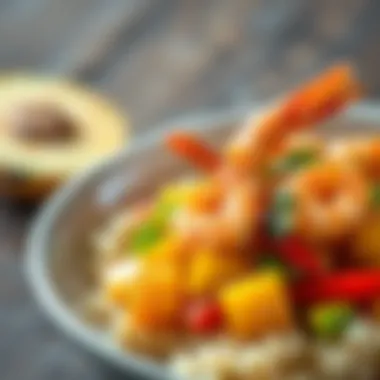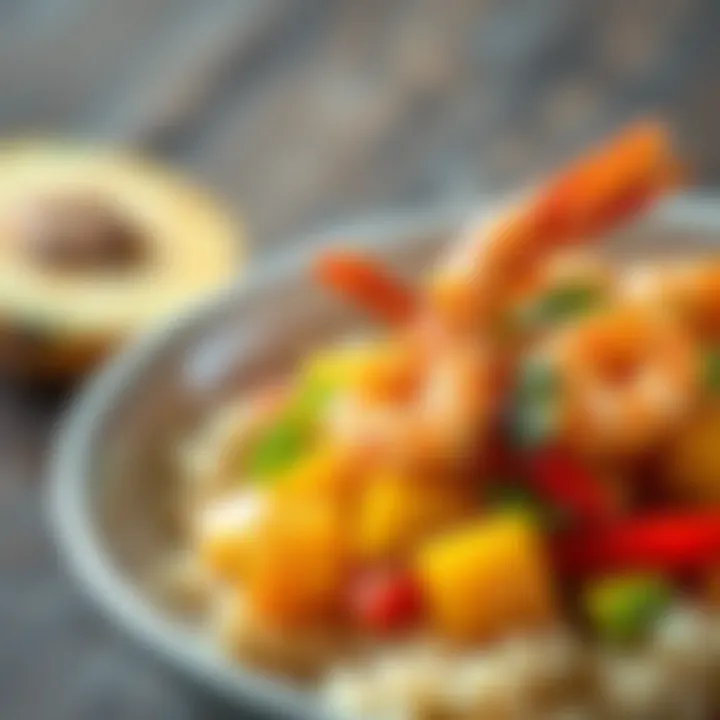Delicious Pineapple Dishes for Every Occasion


Intro
Pineapples bring a unique zing to the culinary table. The vibrant tropical fruit is beloved around the globe, whether it’s topping a pizza or blending into a refreshing drink. Its bold sweetness and perennial bright flavor can elevate even the simplest of dishes. In this article, we will embark on a journey through the exquisite world of pineapple dishes, unlocking its potential to delight our taste buds in both savory and sweet forms.
We’ll explore a wide array of recipes, dive into different cultural contexts where pineapple plays a starring role, and unveil innovative approaches to incorporating this fruit into everyday meals. From juicy grilled pineapple slathered in barbecue sauce to delicate pineapple tarts, there’s no shortage of culinary creativity inspired by this versatile fruit.
By understanding the key ingredients that complement pineapple, mastering essential preparation techniques, and considering dietary preferences, home cooks can effortlessly integrate this tropical delight into their meal rotation. Let’s not forget the importance of presentation; a well-displayed dish not only tastes amazing but also looks appealing on the plate.
As we move along, we’ll also address common queries and challenges that cooks may face, offering helpful tips to steer clear of pitfalls. Get ready to roll up your sleeves and meet the king of fruits, as we explore and appreciate the many ways in which pineapple can be celebrated in our kitchens!
Foreword to Pineapple in Culinary Arts
Pineapples have woven themselves into the fabric of culinary arts across the globe. From their robust sweetness to their unique tartness, they offer a remarkable versatility that both home cooks and fine dining chefs cherish. This section highlights the significance of pineapples in cooking, tracing their journey from tropical forests to our plates.
Historically, pineapples were a symbol of hospitality. They were rare treasures, often reserved for special occasions. This notion still resonates today, as serving a pineapple dish can convey warmth and generosity. The fruit's ability to adapt to various cuisines—from the spicy dishes of Thailand to the sweet treats of the Caribbean—demonstrates its global appeal and culinary potential.
Moreover, incorporating pineapples into meals is not just about flavor; it also has various health benefits. Rich in vitamins and enzymes, pineapples contribute to overall nutrition. This practical aspect makes them a mainstay in healthy cooking.
Historical Significance of Pineapples
Pineapples, native to South America, have a storied history. Once discovered by Europeans in the 16th century, they became a coveted commodity. The fruit was brought back to Europe, where it became an emblem of status. Only the wealthy could afford to own or serve such a rare item. The labor-intensive process of growing and transporting pineapples meant that they were often a mark of extravagance, frequently featured at royal banquets and lavish gatherings.
In time, cultivation techniques improved and plantations sprung up, allowing the fruit to reach a broader audience. This transformation facilitated the pineapple's assimilation into various traditional dishes worldwide, from Indonesian rendang to Hawaiian pizza. The vibrant hue and aromatic profiles made it an attractive choice for chefs navigating the culinary landscape. Its historical journey is not just a tale of trade but also one of cultural exchange that changed how we perceive and enjoy this tropical fruit.
Nutritional Benefits of Pineapple
Pineapple is not just a feast for the eyes and palate; it's nutritionally rich, too. A mere cup of fresh pineapple is packed with essential vitamins such as vitamin C, B vitamins, and minerals like manganese and potassium.
Here are a few notable nutritional aspects of this delicious fruit:
- Vitamin C: Vital for the immune system, it helps the body fight off infections and boosts collagen production for skin health.
- Bromelain: This enzyme aids in digestion and has anti-inflammatory properties, potentially assisting in the recovery from injuries.
- Manganese: Important for bone health and the metabolism of carbohydrates, proteins, and fats.
- Fiber: Aids in digestion, helping to regulate bowel movements and preventing constipation.
Eating pineapple can contribute to overall wellness, making it a wise choice for those looking to enhance their diet. It's not surprising that many health-conscious individuals consider pineapple to be a superfood; it certainly packs a punch when it comes to flavor and health benefits.
Savory Pineapple Dishes
Savory pineapple dishes bring a unique twist to the culinary landscape. This section emphasizes how pineapple isn’t just for desserts; it can play a crucial role in savory meals as well. The sweetness of pineapple, combined with its tangy flavor, provides a refreshing contrast to traditional savory ingredients. People often miss out on the diverse applications of pineapple in savory contexts, but incorporating it into dishes like stir-fries or tacos can truly enhance their flavor profile. This section aims to broaden the perspective of cooks exploring pineapple's versatility.
Pineapple Fried Rice: A Fusion Delight
This dish is a delightful mélange of flavors, where the sweetness of pineapple intersects with the savouriness of fried rice. Imagine a crowded kitchen, the sizzling sound of rice frying in a pan, creating an atmosphere that beckons everyone to gather around. Pineapple fried rice combines jasmine rice, fresh pineapple chunks, peas, and carrots, all cooked in a savory mixture of soy sauce and spices. This dish embodies a perfect balance, offering a harmony of flavors that’s both fulfilling and light. It's a comfort food that transports eaters to tropical locales while allowing for a dash of creativity through the addition of proteins or other vegetables.
Grilled Pineapple with Glazed Proteins
Grilling pineapple not only intensifies its sweetness but also caramelizes the sugars, creating an exhilarating taste that perfectly complements grilled meats. This cooking method can transform mundane proteins into gourmet experiences that dazzle the palate. The grilled version of this delicious fruit can be matched with chicken, pork, or even salmon.
Meat Pairings
When discussing meat pairings, grilled pineapple shines as a versatile option. For instance, pork chops brushed with a sweet pineapple marinade can amplify the meat’s natural flavors. The juicy texture of pineapple helps to tenderize the protein, making it succulent and bursting with flavor. Additionally, beef dishes benefit from the sweet contrast that grilled pineapple offers.
- Pineapple's tartness balances the richness of fatty cuts, enriching each bite and making every meal a significant experience.
On the downside, some might feel the strong flavors of certain meats can clash with the fruit's sweetness. However, when paired thoughtfully, even robust meats can turn into a culinary masterpiece, bringing something new to the table.


Vegetarian Options
Not limited to meat dishes, grilled pineapple also aligns beautifully with vegetarian cuisine. For instance, grilled haloumi cheese drizzled with a pineapple glaze creates a dish that delights the senses while being entirely plant-based. The salty yet creamy texture of the cheese interacts splendidly with the juicy, caramelized chunks of pineapple. This combination is not just palatable but elevates simple vegetarian cooking greatly.
Vegetarian options for pineapple dishes can also include grilled vegetable skewers, where the sweetness of pineapple acts as a counterpoint to earthy flavors. While not everyone’s cup of tea – those who prefer meat-heavy meals might overlook vegetarian alternatives; those who try them are often pleasantly surprised.
Tacos with Pineapple Salsa
Tacos are limitless in their potential combinations, and pineapple salsa is one that deserves the spotlight. To prepare this vibrant topping, finely chop fresh pineapple, tomatoes, onions, and cilantro, adding a squeeze of lime juice for brightness. The contrasting textures and tangy flavors create a mouthwatering topping for soft or hard shell tacos. The tartness of the pineapple brings a refreshing pop that balances spicy ingredients such as jalapeños. It creates a fusion that’s both refreshing and satisfying, elevating the humble taco to a new level.
Pineapple and Shrimp Skewers
These skewers encapsulate a tropical vibe, ideal for barbecues or summer gatherings. The strong flavor of shrimp, marinated in a mixture of garlic, lime, and spices, marries seamlessly with the sweetness of pineapple. Alternating pieces of shrimp and pineapple on skewers creates an appealing visual, as well as a delightful contrast between the juicy, tender shrimp and the caramelized pineapple. The skewers are photo-worthy and delicious, showcasing the beauty of blending contrasting ingredients. In essence, savory pineapple dishes provide not only a flavor harmony but also creative visual aesthetics on the plate.
Sweet Pineapple Dishes
The allure of sweet pineapple dishes resonates profoundly in the culinary world. They harness the tropical essence of pineapple, transforming the fruit into delightful desserts that tantalize taste buds. Not only do these dishes offer a refreshing finish to any meal, but they also highlight the versatility of pineapple, showcasing its ability to shine in both traditional and innovative recipes.
One significant benefit of sweet pineapple dishes is their impressive ability to balance flavors. The natural sweetness of pineapple combined with a hint of acidity creates a dynamic flavor profile. This duality not only satisfies those craving something sugary but also provides a refreshing break from richer dishes. The texture of pineapple also plays a vital role, bringing a juicy and silky touch to desserts, which can enhance the overall eating experience.
Considering these points, it’s clear that sweet pineapple dishes are not mere afterthoughts; they are culinary gems worthy of exploration. Let's delve into a few standout recipes that showcase the myriad ways pineapple can be utilized in sweet forms.
Pineapple Upside-Down Cake: A Classic
Pineapple Upside-Down Cake is like a slice of nostalgia served on a plate. Its origins date back to the early 1920s and have remained a staple in many households ever since. This cake boasts a beautiful caramelized layer of pineapple rings and cherries atop a moist cake base. The preparation is quite straightforward, making it accessible for novice bakers and seasoned pastry chefs alike.
To create a Pineapple Upside-Down Cake, begin by melting butter in a cast-iron skillet. Sprinkle brown sugar evenly over the melted butter, allowing it to bubble just a tad. Next, arrange the pineapple slices in a charming pattern, tucking maraschino cherries in between. Prepare your cake batter by mixing flour, sugar, and eggs, and pour this mixture over the fruit. After baking, the cake is inverted to reveal its luxurious topping. This method of cooking not only results in a moist cake but also transforms the pineapple into a succulent topping that’s hard to resist.
Pineapple Sorbet: A Refreshing Treat
When the heat is relentless, a scoop of Pineapple Sorbet is often the perfect antidote. Made predominantly from ripe pineapple pureed into a silky smooth consistency, this frozen dessert captures the very essence of summer. Its simplicity is one of its greatest appeals, requiring minimal ingredients while providing maximum refreshment.
To whip up Pineapple Sorbet, blend ripe pineapple chunks with sugar and lime juice until smooth. Chilling the mixture and subsequently freezing it allows for a delightful texture. With a mere handful of defined ingredients, this dessert stands testament to the flavor of fresh pineapple. The vibrant color and rich taste can transport you to sun-soaked shores with every spoonful, making it an enticing treat for all ages.
Pineapple Tarts: An Elegant Dessert
Pineapple tarts often steal the spotlight at gatherings, holding their own as a sophisticated delicacy. Typically found in Southeast Asian cuisines, these tarts feature a flaky pastry shell filled with sweetened pineapple jam. The combination of the buttery crust and the tart filling creates a delicate balance of flavors, making each bite an elegant treat.
To make Pineapple Tarts, start with crafting a buttery and flaky pastry by creaming butter and sugar, then adding flour. After forming the dough and chilling it, roll it out and shape it into small tartlets. The filling is created by cooking pineapple pulp with sugar until thickened, transforming it into a jam-like consistency. Once assembled, these tarts can be baked until golden brown, resulting in a visually appealing dessert that bursts with flavor.
If you've never tasted these desserts, you’re missing out on the sweet symphony that pineapple can harmonize on your palate.
For additional insights, consider visiting Wikipedia or Britannica for more detailed information.
International Pineapple Recipes
Pineapple's global appeal stretches from sunny shores of Hawaii to the vibrant landscapes of Thai markets, making it an ingredient that fits seamlessly into various cultural cuisines. Given its sweetness, acidity, and juicy texture, discussing international pineapple recipes in this article not only broadens the culinary horizon but also highlights how versatile this fruit truly is. Cooking with pineapple can offer unique flavor combinations that surprise the palate and elevate traditional meals. Home cooks can explore these culinary traditions to bring a world of taste into their own kitchens.
Hawaiian Cuisine: Beyond the Pizza
When one thinks of pineapple, Hawaiian pizza often comes to mind. However, there's so much more that this island's cuisine has to offer featuring pineapple. Think about the classic dish, Huli Huli chicken. This delightful savory recipe involves marinating chicken in a mixture that includes pineapple juice, soy sauce, and ginger before it’s grilled to perfection. Not only does the pineapple add a sweet note to the chicken, it tenderizes the meat beautifully while keeping it juicy.
One can also explore pineapple poke, a fresh twist on the traditional poke bowl. Incorporating diced pineapple into the mix adds an unexpected burst of sweetness that contrasts perfectly with the salty soy sauce and rich avocado. These dishes highlight the harmonious blend of tropical fruits with local produce, showcasing Hawaiian flavors that truly celebrate the pineapples that thrive in the volcanic soil of the islands.
Thai Pineapple Curry: A Unique Experience


In Thailand, pineapple takes center stage in dishes like Pineapple Curry, or Kaeng Pha. This dish delights the senses with its fragrant herbs and spices while presenting a unique blend of sweet and savory. Thai chefs often combine chicken or shrimp with fresh pineapple chunks, coconut milk, and a medley of herbs including basil and cilantro. This balance between sweetness and heat characterizes much of Thai cuisine, making each bite a revelation.
To bring the experience home, consider adopting a simple recipe utilizing fresh pineapple chunks, curry paste, and creamy coconut milk. A squeeze of lime right before serving adds an invigorating touch, inviting diners to relish the nuanced layers of flavors. This dish not only embodies the vibrant culinary art of Thailand but also emphasizes the importance of using fresh ingredients in creating authentic flavors.
Caribbean Pineapple Dishes: A Fusion of Flavors
The Caribbean islands present a tapestry of flavors where pineapple shines in many forms. Dishes like Jerk Chicken with Pineapple Salsa become a testament to the fusion of sweet, spicy, and savory elements. The spicy kick of jerk seasoning paired with the refreshing sweetness of a pineapple salsa results in a delightful explosion of flavors. It's a dance of textures and tastes that can turn any meal into a festive occasion.
Adding to that, the Caribbean Pineapple Rice is another dish that captures the island’s culinary spirit. The rice is often cooked with coconut milk and mixed with raisins, vegetables, and pineapple, creating a tropical medley that leaves diners wanting more. This transcultural twist lets chefs play with flavor profiles, using fresh ingredients that are abundant in the region.
"The beauty of pineapple lies in its adaptability, enhancing both savory and sweet dishes across the globe."
- For more about Hawaiian cuisine, check out Wikipedia's page on Hawaiian cuisine.
- Dive deeper into Thai cooking techniques at ThaiFoodNetwork.
- Explore Caribbean dishes at BBC Good Food Caribbean.
Cooking Techniques with Pineapple
Understanding cooking techniques with pineapple opens up a plethora of culinary possibilities. It's not just about adding a sweet flavor; it’s about manipulating texture, enhancing aromas, and bringing balance to dishes that might otherwise lack depth. By employing precise methods, one can unlock new dimensions of taste and presentation. It’s crucial for home cooks and culinary enthusiasts to know that these techniques can elevate ordinary meals into extraordinary experiences. Here we highlight three essential methods: grilling, roasting, and incorporating pineapple into marinades.
Grilling: Enhancing the Sweetness
Grilling pineapple has a magical way of concentrating its natural sweetness while adding an alluring char to its exterior. The process caramelizes the sugars, transforming the fruit into something both sophisticated and satisfying. When you throw slices of fresh pineapple onto a hot grill, listen for that juicy sizzle—it’s the sound of delightful flavor development.
To achieve the best results, cut pineapple into rings or thick wedges, ensuring even cooking and making them easier to handle. Before grilling, marinating the pineapple in a mix of honey and lime juice can work wonders. This combination not only enhances the sweetness but also introduces a zesty kick that harmonizes beautifully with the smokiness from the grill.
When the pineapple has nice grill marks and a tender yet firm texture, it’s ready. You can serve it alongside grilled meats or even as a dessert topped with ice cream or mint leaves. The versatility of grilled pineapple is undeniable; it's a welcome depth in tacos, salads, or even alongside savory rice dishes.
Roasting Pineapple for Enhanced Flavor
Roasting brings out a different side of pineapple, one that is more profound and rich. The heat in the oven transforms the softness of the fruit, allowing it to exude a warm, caramel-like nuance. This cooking method is less common but can elevate comfort food to gourmet status. By slicing the pineapple into chunks and coating them lightly in brown sugar or cinnamon, one can boost their natural flavor, creating a treat that is both comforting and intriguing.
When roasting, it’s essential to ensure even distribution on the baking sheet. This promises that every piece receives heat uniformly, which is key to avoiding overly mushy spots. Roasting at a moderate temperature allows for gradual caramelization without burning.
Use roasted pineapple in fruit salads, as a side to savory pork dishes, or whirled into a sauce for a unique twist. Its rich, warm character contrasts intriguingly with cool, creamy textures, making it a versatile component in various culinary landscapes.
Using Pineapple in Marinades
Pineapple boasts natural enzymes, particularly bromelain, which can break down proteins. This quality makes it particularly effective in marinades, tenderizing meats and infusing them with flavor. When creating a marinade, combining pineapple juice with soy sauce, garlic, and ginger can yield a blend that tantalizes the palate. Marinades should ideally rest for a few hours, allowing time for those flavors to seep in deeply.
The inclusion of pineapple juice not only contributes to tenderness but also delivers an underlying sweetness, creating a balanced flavor profile when grilled or baked. Whether marinating chicken, beef, or even tofu for vegetarian dishes, pineapple can add a layer of complexity that transforms the entire dish.
Using pineapple in marinades is a clever way to ensure your dishes remain moist while boosting flavor, making it a must-have technique in your culinary repertoire.
"Cooking with pineapple is like having a party in your mouth; you never quite know all the flavors that will dance together!"
Incorporating these cooking techniques will guarantee your pineapple dishes are bursting with flavor and texture. Make sure to experiment and discover where pineapple fits into your own culinary journey.
Pairing Pineapple with Other Ingredients
When it comes to cooking, knowing how to pair ingredients is essential. Pineapple, with its robust sweetness and tangy bite, opens up a world of culinary possibilities. It can elevate a dish from good to memorable. In this section, we will explore the complementary flavors of pineapple and the herbs and spices that work in harmony with it.
Complementary Flavors: A Study
Pineapple's natural sweetness allows it to blend seamlessly with a variety of flavors. Here are some noteworthy pairings:
- Coconut: The creamy richness of coconut milk balances the tartness of pineapple, making it a staple in tropical dishes. Try it in curries or smoothies for an authentic island vibe.
- Chili Peppers: Adding a kick of heat can elevate pineapple's flavor. The spicy notes bring a contrast that can make a dish both surprising and unforgettable. Think of pineapple salsa served with grilled chicken.
- Citrus Fruits: Lemon, lime, or orange zest adds a bright layer to pineapple dishes. This can be particularly excellent in marinades or dressings for salads.
- Pork and Ham: The saltiness of cured meats notably enhances the sweetness of pineapple, working well in dishes like ham with a pineapple glaze or sweet and sour pork.


One might ask, how do these combinations benefit our culinary creations? Using complementary flavors not only improves taste but also adds complexity to your dishes. When you jar together sweet, spicy, and sour notes, you craft a palate experience that draws people in.
Herbs and Spices that Enhance Pineapple
Herbs and spices can turn a straightforward pineapple dish into a sensational one. Here are a few that can amplify its flavors:
- Mint: This aromatic herb adds a refreshing quality. Consider using mint in a pineapple salad or crafting a refreshing drink.
- Cilantro: With its sharp flavor, cilantro can brighten up pineapple salsas or even be sprinkled on grilled pineapple slices alongside fish.
- Ginger: The warmth of ginger plays nicely with the fruit's tartness. A touch of ginger can transform a simple pineapple stir-fry into something exceptional.
- Cinnamon: Often used in desserts, cinnamon adds a warming spice that complements pineapple's natural sweetness.
In essence, pairing pineapple with the right ingredients can elevate your culinary repertoire. Whether you're creating sweet desserts or refreshing beverages, ensuring balance through complementary flavors and adding herbs and spices will lead to beautifully crafted dishes. The versatility of pineapple makes it an excellent choice for experimenting in the kitchen.
"Pineapple can be more than just a sweet addition; it’s a bridge to stunning culinary adventure when paired correctly."
For further inspiration, consider exploring culinary resources like Wikipedia, Britannica, or food forums like Reddit where enthusiasts share their favorite recipes and pairings.
Presentation Techniques for Pineapple Dishes
Presentation is not just for show; it’s an integral part of the culinary experience. In the context of pineapple dishes, effective presentation techniques can elevate the sensory appeal. The visual aesthetics of a dish can incorporate colors, shapes, and textures that tease the palate even before the first bite. When readers explore pineapple dishes in this article, they will discover how thoughtful plating and beautiful garnishing can enhance not just the dish itself but the overall dining experience.
The true magic of pineapple, with its striking golden hue and natural juiciness, lends itself particularly well to imaginative presentations. Using contrasting colors, for instance, can make pineapple's vibrant shade pop even more against darker plates, creating an exquisite visual treat. Equally important is considering the shape and form of the pineapple—slices, chunks, or even spirals can change how the dish is perceived. A rustic pineapple salad served in a hollowed pineapple shell can offer an exotic flair, making the presentation an extension of the dish's flavor.
Furthermore, utilizing the right utensils and garnishing strategies can either align with or enhance the dish's theme. The aim is to create a feast for the eyes that beckons the diners to indulge their appetite. In engaging with the art of plating, one can consider various factors such as layer arrangements, height creation, and negative space, ultimately crafting an exceptional presentation that resonates with gastronomic delight.
"Presentation is about creating a narrative; it beckons the diner to discover what lies beyond the aesthetics."
Plating Styles for Elegant Displays
Plating styles are pivotal in determining how pineapple dishes are perceived. When plating, several renowned styles can be adopted, each of which can blend with the tropical essence of pineapple.
- The Classic Method: This boasts cleanliness and elegance. Place a portion of pineapple on a white plate with a simple drizzle of sauce. This allows the colors and flavors to shine uninterrupted, appealing to a more formal setting.
- The Landscape Approach: Here, the plate transforms into a mini canvas. Use an artful arrangement of sauces to define areas and create movement on the plate. For instance, pineapple slices could accompany grilled chicken, with streaks of mango sauce artfully zigzagged to mimic the ocean waves.
- Stacking: Another engaging option, stacking pineapple slices alternately with herbs or cheese can create a tower of flavors and textures. This style, often seen in contemporary restaurants, can also lend a modern twist to home-cooked meals.
- The Deconstructed Style: Rather than presenting a finished dish, this approach involves serving ingredients separately. A deconstructed pineapple upside-down cake might present the individual components, such as caramelized pineapple, sponge cake fragments, and whipped cream on the side.
Garnishes that Elevate Presentation
Garnishing is an art that can greatly enhance the visual appeal of pineapple dishes. The right garnish can complement or even contrast the dish’s flavor, establishing a beautiful connection among ingredients.
- Fresh Herbs: Sprigs of mint, cilantro, or basil can contrast nicely against pineapple’s sweetness. A little green goes a long way, stimulating the eyes and palate alike.
- Edible Flowers: These can lend a touch of elegance, turning a simple dish into something spectacle-worthy. Consider scattering a few nasturtium petals around the plate to bring color and vibrancy—sure to catch the attention of all.
- Citrus Zest: Grating some lime or lemon zest over a pineapple dish adds not only brightness but also a refreshing aroma that tantalizes the senses and balances the sweetness.
- Spices: A dusting of chili powder or a sprinkle of cinnamon can add an unexpected burst of flavor and visual intrigue. Just a hint of spice can create an interesting juxtaposition against the fruit's natural sweetness.
Ultimately, the success of any presentation hinges on a balance between artistry and simplicity. Creating pineapple dishes that are not only appetizing but also stunningly presented can make a lasting impression on diners. It’s all about leaving tantalizing memories on the palate long after the meal is finished.
The End: The Versatility of Pineapple
Pineapple is more than just a tropical treat; it represents a journey through diverse culinary landscapes. This article has showcased its remarkable adaptability in both savory and sweet domains, illustrating how a single fruit can add zest to various dishes. The importance of pineapple lies not just in its flavor but also in its ability to bridge different cuisines, marrying ingredients from diverse backgrounds and creating dishes that resonate with people from all walks of life.
One major takeaway is how pineapple can enhance flavors—the fruit’s inherent sweetness and acidity play a crucial role in creating balance within meals. Whether it’s softening the raw bite of spices in a curry or elevating the richness of a meat dish, pineapple stands its ground as a formidable ingredient. The juicy texture contributes to the mouthfeel, inviting one to relish every bite. It’s a taste experience akin to finding a hidden gem in a familiar landscape—you expect to enjoy the view, but you’re surprised by just how breathtaking it can truly be.
As noted throughout the article, utilizing pineapple in cooking allows for culinary experimentation. Ingredients that pair beautifully with pineapple vary widely—from the richness of coconut milk to the savory crunch of herbs. This flexibility encourages cooks to venture beyond traditional recipes and to explore the creative process in the kitchen. Experimenting with different spices and cooking techniques can yield astonishing results and provides opportunities for culinary innovation that can be both rewarding and delicious.
"In cooking, as in life, there's freedom in daring to experiment. Pineapple serves as a catalyst for creativity—embracing it means embracing a world of flavor possibilities."
To add to this, the nutritional benefits of the fruit certainly enhance its appeal; packed with vitamins, antioxidants, and bromelain, pineapple is not only tasty but also contributes positively to health.
In summary, pineapple’s versatility isn’t merely a statement of taste, but a call to action for anyone in the kitchen. By encouraging culinary exploration and creativity, this tropical fruit proves to be a delightful ingredient that should find its way into every home cook’s repertoire. Whether you are preparing a crafted dish for a gathering or simply trying something new for dinner, incorporating pineapple inspires confidence to try flavors that challenge the norm. The kitchen becomes a canvas, with pineapple as one of the boldest colors on the palette—exciting and vibrant, just like life should be.
Encouraging Culinary Experimentation
When it comes to cooking with pineapple, stifling oneself to traditional recipes can be a missed opportunity. Encouraging culinary experimentation invites a world of flavors into your kitchen. Consider this: mixing pineapple with unexpected partners can open the door to unique dishes that tantalize taste buds.
Start by reflecting on what flavor profiles you enjoy. Do you prefer sweet and savory? If so, think of creating a spicy pineapple salsa to accompany grilled chicken or fish. The sweetness of the pineapple counteracts the heat of spices, harmonizing beautifully. You can also blend pineapple into smoothies, providing natural sweetness to fruits and vegetables, and creating vibrant, nutrient-rich drinks.
Here are some other creative ideas to spark your culinary adventures:
- Infusing sauces or dressings with pineapple juice or purée for added sweetness and acidity.
- Experimenting with marinated dishes, using pineapple juice as a tenderizer and flavor enhancer.
- Making a savory pineapple chutney to serve alongside curries or barbecued meats.
- Mixing diced pineapple with quinoa or couscous for a refreshing salad with a tropical twist.
- Baking pineapple into unconventional items like muffins, pancakes, or even pizza, to surprise your guests.
With a dash of imagination and a pinch of daring, the possibilities are endless. Be bold, try new things, and let the pineapple guide your way into the vibrant world of culinary exploration.







